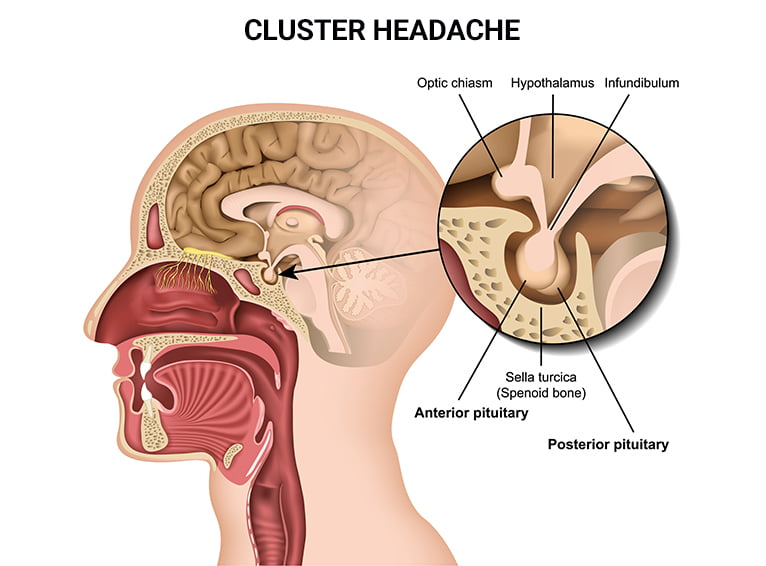Headaches are one of the worst types of pain that anyone can experience. Not only are they uncomfortable, but they can also affect your productivity and quality of life. While headaches are already hard to deal with, some people also suffer from feeling intense pressure or strain behind their eyes.
So what’s the reason behind eye pain with headaches and how do you treat it? It may be a sign of a migraine attack, sinus infection, or cluster or tension-type headache. It may also be caused by underlying eye conditions like optic neuritis or glaucoma. Some common solutions for headaches with eye pain are medications, chiropractic care, intravenous infusion, and sphenopalatine ganglion blocks.
Different Types of Headaches That May Spread Behind Your Eyes
Some kinds of headaches come and go, but there are those that last for a few days and may happen along with pulsating eye pressure. Having eye pain with daily headaches can affect one or both sides and it may lead to vision disturbances, increased light sensitivity, or trouble focusing on your daily tasks.
Headache behind the eyes can mean a lot of things from cluster headache attacks, tension headaches, or chronic migraines. It can also be caused by sinus headaches and occur with other nasal symptoms.
To better understand, here are the different types of headache disorders and how they can cause eye pain:
1) Cluster Headache
This primary headache condition is one of the leading causes of pain that radiates to one or both eyes. Most of the time, the head pain that occurs with this condition feels intense and comes in phases known as cluster periods. Severe headache attacks of this type can last for 30 minutes to an hour and may recur for a few weeks or months.
It’s hard to pinpoint the exact cause of cluster headaches but according to its patterns, experts suggest that it may be related to a sudden release of chemicals in the area of the brain involving the trigeminal nerve.
When cluster headaches occur, it’s not uncommon to feel pain behind the eye region and temples. They may also cause neck pain, shoulder pain, eyelid drooping, watery eyes, facial sweating, or nasal congestion.

2) Migraine Headache
Another possible cause of severe eye pain with headaches is an acute or recurring migraine. According to the American Migraine Foundation, this disorder affects roughly 37 million individuals each year. Most migraine attacks happen in stages: prodrome, aura, headache, and postdrome. However, not everyone who gets migraine experiences all stages.
Pain around or behind the eyes and other visual symptoms usually occur during the aura phase of a migraine attack. Some of the common causes of migraine headaches with aura are exposure to bright or flashing lights, stress, hormone changes, or certain foods and medication.
Eye pain may also happen with retinal or ocular migraine. This disorder typically causes temporary blindness or blurred vision along with a sharp or throbbing pain that spreads to the head. This type of migraine occurs when there’s build-up of inflammation in the blood vessels in the optic nerve and the brain.
3) Tension Headache
Eye pain is also commonly associated with tension headaches. It’s one of the most common types of headache disorders that occurs when the muscles at the back of your head, scalp, and neck become too tight or contracted.
People with tension headaches describe the pain symptom as a tightening or squeezing like a band around both sides of the head and may spread to the muscles around the eyes. Its symptoms are constant but it doesn’t necessarily throb like what you’d normally experience with a migraine attack.
4) Sinus Headache
Eye pain may also occur with a secondary headache such as sinus headaches. The buildup of sinus pressure often leads to pain that travels along the bridge of the nose, cheekbones, and around or behind the eyes.
The symptoms of a sinus headache are sometimes similar to a migraine attack. However, eye pain and headaches with sinusitis aren’t easily triggered by light exposure and rarely cause nausea or vomiting. It’s more commonly accompanied by fever, stuffy nose, and thick discolored nasal discharge due to the presence of a sinus infection.
Your Vision and Headaches: What’s The Connection?
Headaches are a complex disorder. While it’s common to think that head pain starts in the brain, it can originate from various nerves, muscles, and blood vessels in the body. When you encounter certain headache triggers, specific nerve endings may react and send a signal to your brain which causes the painful sensation.
Eye pain with headaches can occur when inflammation, decreased blood flow, damage, or traumatic injury happens to the optic nerve. This nerve is an important part of the central nervous system which transmits signals and electric impulses from the eyes to the brain.
In other cases, headaches may also be a sign that you have an underlying eye problem. Here are some common eye conditions that can cause moderate to severe headache pain:
1) Eye Strain
Spending too much time on the computer, using your phone for prolonged hours, or working without sufficient lighting can cause eye strain. Like any muscle in the body, your eyes are also prone to getting tired after intense use without taking breaks. Along with a sudden onset of headache, you may also feel dry eye symptoms, sore neck, and blurred vision with eye strain.
2) Optic Neuritis
This eye condition refers to the swelling or inflammation of the optic nerve. Patients with optic neuritis can experience pain with eye or head movement, temporary vision loss, reduced color perception, and flashing lights. It can also cause debilitating pain on one or both sides of the head.
3) Glaucoma
Chronic headaches and eye pain may also be caused by angle-closure glaucoma. It’s a condition that occurs when fluid accumulates in the eye and leads to damage to the optic nerve. This may cause throbbing pain that’s felt around the eyes and forehead and is accompanied by blurred vision, eye redness, nausea, and vomiting.
4) Astigmatism
Individuals diagnosed with astigmatism may also experience frequent headaches behind the eyes. This is typically a refractive error where the cornea or lens of the eyes has an unusual curvature or isn’t shaped normally. This can lead to symptoms such as eye strain, distorted vision, squinting, and recurring headaches.
Possible Triggers of Headache Pain Behind Eyes
Fortunately, most cases of headaches behind the eyes aren’t serious or life-threatening. They can also be easily managed by avoiding exposure to triggers and taking care of your eye health.
Here are some of the potential causes of sudden eye pain and headache symptoms:
- Hormonal changes
- Sleep deprivation
- Too much stress
- Digital eye strain
- Exposure to strong odors
- Infections
- Existing vision problems
- Excessive noise or loud sounds
- Bright or blinding lights
- Not getting enough food or water
- Poor posture
When to See a Doctor for Headache Behind Eyes
There are several home remedies that can help ease eye pain with headaches. However, if your symptoms don’t improve after resting or taking pain medicine, it may be a sign of an underlying problem. Here are other indications that you need to see an eye doctor or neurologist for your discomfort:
- You experience severe pain that lasts for more than 2 days
- Your headache attacks are accompanied by fever
- You’re having difficulty concentrating or seeing due to changes in vision
- You notice drooping of one or both eyelids
- You’re experiencing facial pain, numbness, or weakness
- You experience sudden nausea or vomiting
How Our Team at Advanced Headache Center Treats Headache Behind Eyes
There’s nothing more assuring than having an expert doctor diagnose your headache pain and give you the best treatments for immediate and lasting relief. Here at Advanced Headache Center, our highly-trained and experienced team can provide a customized treatment plan to address your specific head and eye pain symptoms.
Here are some of the common treatment options that our team can recommend for headaches behind the eyes:
1) Medications
Taking prescription drugs and over-the-counter medications is usually the first-line treatment for headaches behind the eyes. Aside from providing fast-acting relief, they can also reduce the frequency and severity of your headache and eye pain.
Some of the medications that can help with headaches behind the eyes are:
- Non-steroidal inflammatory drugs such as ibuprofen or naproxen
- Triptan medication such as almotriptan, naratriptan, and sumatriptan
- Tricyclic antidepressants can improve the levels of serotonin to counter the head pain
- Beta-blockers can help lowers the impact of stress on your blood vessels
- Calcium channel blockers can regulate blood pressure and prevent migraine or cluster headache attacks
2) Acupuncture
This alternative therapy is one of the most popular forms of traditional Chinese medicine and it’s widely used to treat various pain conditions. As a headache treatment, the acupuncture needle is inserted into different pressure points which will stimulate the release of certain hormones to help you relax and take your mind off the pain. It’s also suggested that acupuncture improves blood flow to decrease the tension in the affected muscles.
3) Intravenous Infusion
If you’re experiencing persistent headaches due to dehydration, you can benefit from our intravenous infusion treatments. IV therapies usually consist of various essential vitamins, nutrients, and minerals that can help ease the symptoms of your head and eye pain. Since it’s an intravenous treatment, the IV solution is delivered directly to the bloodstream through your veins so you can have instant relief.
4) Sphenopalatine Ganglion Block
This treatment targets the sphenopalatine ganglion which is a group of nerves behind the nose that often causes chronic migraines, cluster headaches, and facial pain. In this procedure, local anesthetics are given directly to the nerves using a soft catheter which is carefully inserted by our doctor.
Get Quality Care for Your Head and Eye Pain at Advanced Headache Center
When eye pain occurs with a headache, it can make you lose concentration and lead to several vision problems. Although some cases of headaches behind the eyes may resolve on their own, it’s recommended to see a specialist to properly identify the source of your pain and receive the appropriate treatment for instant relief.
At Advanced Headache Center, we have a team of doctors who can provide a comprehensive diagnosis of your headache and eye pain. We use a multimodal approach involving nerve blocks, medications, and injections to help you achieve long-lasting pain relief. Contact us today for a consultation and know more about our treatment options for your head and eye pain.




